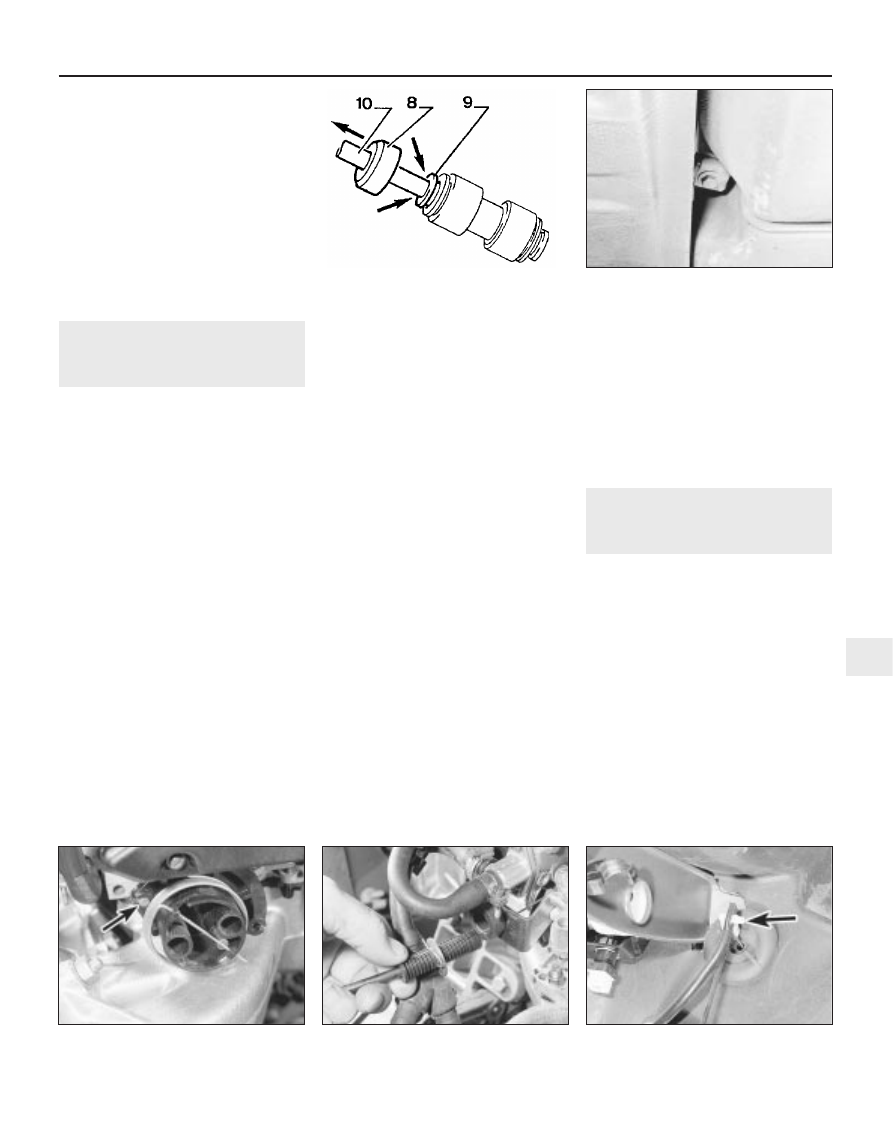содержание .. 28 29 30 31 ..
Peugeot 405. Manual - part 30

Refitting
8 Refitting is a reversal of the removal
procedure, noting the following points:
a) Prior to refitting, fit a new rubber sealing
ring to the sender unit.
b) Refit the sender unit to the tank, aligning
its arrow with the centre of the three
alignment marks on the fuel tank. Secure
the sender in position with the locking
ring, and check that the locking ring,
sender unit and fuel tank marks are all
correctly aligned.
c) Ensure that the feed and return hoses are
correctly reconnected and securely
retained by their clips.
6
Fuel tank -
removal and refitting
3
Note: Refer to the warning note in Section 1
before proceeding.
Removal
1 Before removing the fuel tank, all fuel must
be drained from the tank. Since a fuel tank
drain plug is not provided, it is preferable to
carry out the removal operation when the tank
is nearly empty. Before proceeding,
disconnect the battery negative lead and
syphon or hand-pump the remaining fuel from
the tank.
2 Remove the exhaust system and relevant
heat shield(s) as described in Section 16.
3 From underneath the vehicle, disconnect
the handbrake cable at the equaliser bracket.
4 Release the handbrake primary cable from
the clips in the fuel tank. Position the cable
clear of the tank, so that it will not hinder the
removal procedure.
5 Disconnect the wiring connector from the
fuel gauge sender unit, as described in
Section 5.
6 Working at the right-hand side of the fuel
tank, release the retaining clips then
disconnect the filler neck vent pipe and main
filler neck hose from the fuel tank/filler neck.
Where necessary, also disconnect the
breather hose(s). Some breather hoses are
joined to the tank with quick-release fittings; to
disconnect these fittings, slide the cover along
the hose then depress the centre ring and pull
the hose out of its fitting (see illustration).
7 Trace the fuel feed and return hoses back
from the right-hand side of the tank to their
union with the fuel pipes. Slacken the
retaining clips and disconnect both hoses
from the fuel pipes. Where the crimped-type
Peugeot hose clips are fitted, cut the clips and
discard them; use standard worm-drive hose
clips on refitting. Plug the hose and pipe ends,
to prevent the entry of dirt into the system.
8 Place a trolley jack with an interposed block
of wood beneath the tank, then raise the jack
until it is supporting the weight of the tank.
9 Slacken and remove the retaining nut and
bolts, then remove the two support rods from
the underside of the tank (see illustration).
10 Slowly lower the fuel tank out of position,
disconnecting any other relevant vent pipes as
they become accessible (where necessary),
and remove the tank from underneath the car.
11 If the tank is contaminated with sediment
or water, remove the sender unit (Section 5),
and swill the tank out with clean fuel. The tank
is injection-moulded from a synthetic material
- if seriously damaged, it should be renewed.
However, in certain cases, it may be possible
to have small leaks or minor damage repaired.
Seek the advice of a specialist before
attempting to repair the fuel tank.
Refitting
12 Refitting is the reverse of the removal
procedure, noting the following points:
a) When lifting the tank back into position,
take care to ensure that none of the hoses
become trapped between the tank and
vehicle body.
b) Ensure that all pipes and hoses are
correctly routed, and securely held in
position with their retaining clips.
c) Reconnect the handbrake cables and
adjust the handbrake (see Chapter 9).
d) On completion, refill the tank with a small
amount of fuel, and check for signs of
leakage prior to taking the vehicle out on
the road.
7
Accelerator cable - removal,
refitting and adjustment
2
Removal
1 Working in the engine compartment, free
the accelerator inner cable from the
carburettor throttle cam, then pull the outer
cable out from its mounting bracket rubber
grommet (see illustrations). Where fitted,
slide the flat washer off the end of the cable,
and remove the spring clip.
2 Working back along the length of the cable,
free it from any retaining clips or ties, noting
its correct routing.
3 Where necessary remove the lower trim
from below the driver’s side of the facia panel.
4 Working from inside the vehicle, disconnect
the cable from the accelerator pedal by
depressing the lugs on the plastic end fitting
and pushing the fitting from the pedal (see
illustration).
Fuel/exhaust systems - carburettor models 4A•5
7.1a Accelerator cable connection on the
throttle quadrant (arrowed)
8 Cover 9 Centre ring 10 Hose
7.4 Accelerator cable connection to
accelerator pedal (arrowed)
7.1b Outer cable end fitting
6.9 Fuel tank support strap bolt
4A
6.6 Tank breather quick-release connector